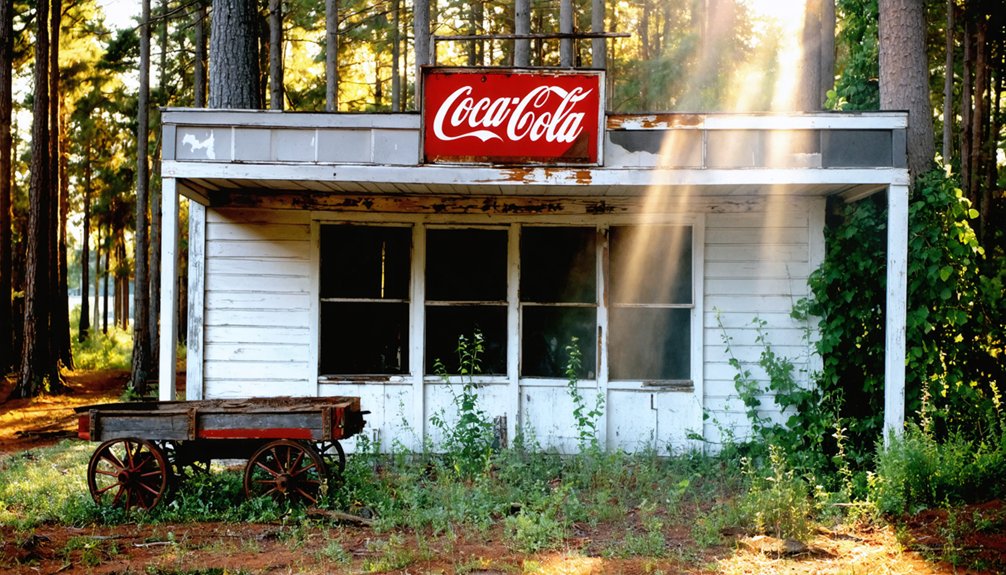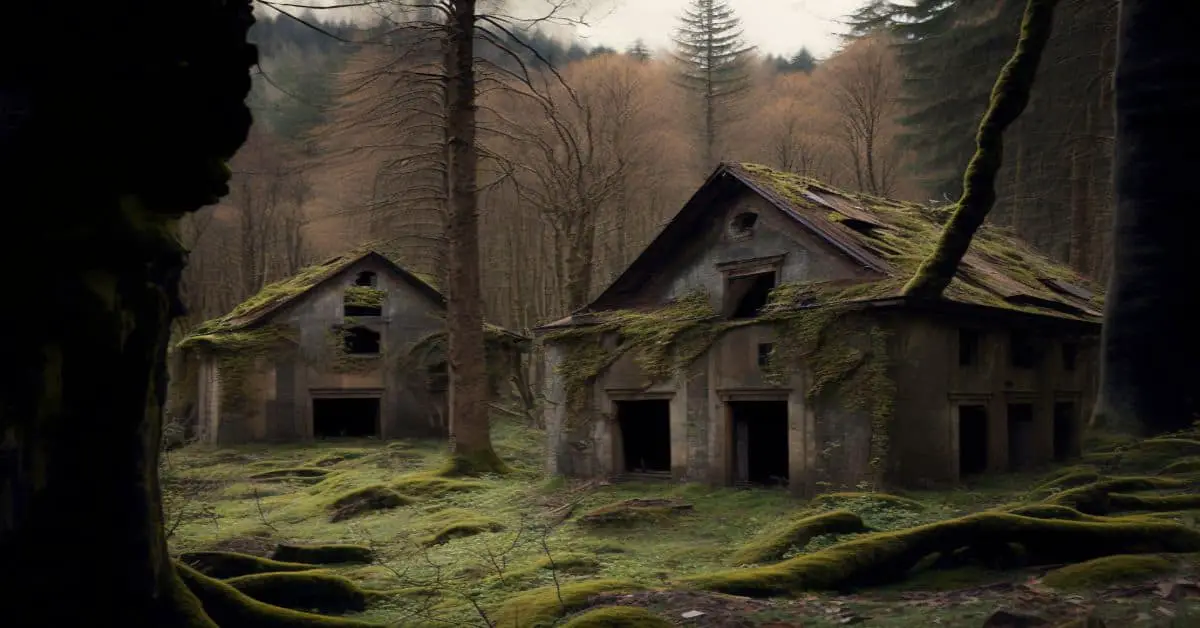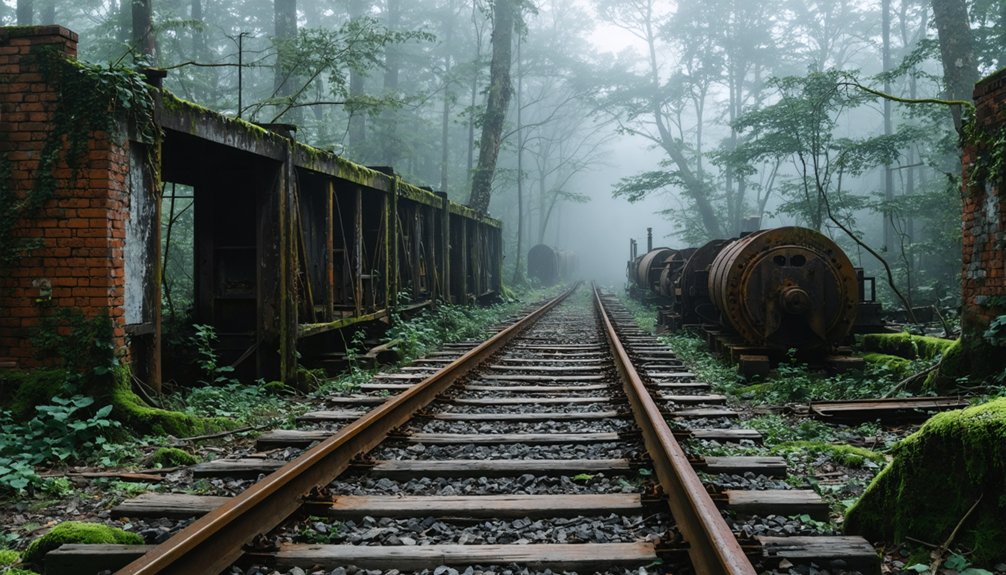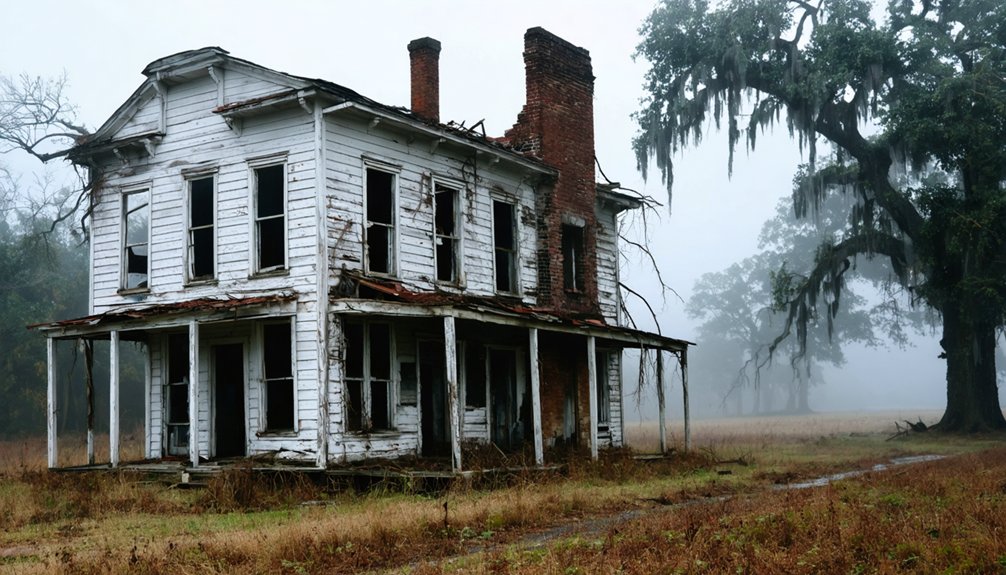You’ll find Constitution tucked away in DeKalb County, Georgia’s only ghost town. Established in 1911 around a bustling railroad depot, this strategic settlement spanned both Fulton and DeKalb counties south of Atlanta. The town emerged amid tensions over Chestnut Hill, a Black cemetery, as local residents sought to control land use during segregation. While the original town has vanished, Constitution Lakes Park now preserves its fascinating legacy of industry, ecology, and folk art.
Key Takeaways
- Constitution, Georgia, established in 1911, is now DeKalb County’s only ghost town, located south of Atlanta near the Southern Railway line.
- Post-World War II suburbanization and declining railroad importance led to population loss and business relocations, ultimately causing the town’s abandonment.
- The town’s remnants are now part of Constitution Lakes Park, featuring wetlands formed from abandoned 19th-century clay quarries.
- Constitution originally grew around its railroad depot with industrial facilities, lodging, and saloons before its eventual decline.
- The town’s formal government structure, which included a mayor and five councilmen, dissolved as the community declined into abandonment.
The Birth of a Unique Southern Settlement
While many Southern settlements emerged organically around trade routes or natural resources, Constitution, Georgia‘s birth in 1911 stemmed from a distinctive set of circumstances.
You’ll find its origins deeply rooted in community tensions surrounding the establishment of Chestnut Hill, a Black cemetery in the area. Local residents responded by formally incorporating the town, complete with a mayor and council.
The settlement’s strategic location south of Atlanta, straddling both Fulton and DeKalb counties, positioned it well for growth. The East Tennessee Railroad played a crucial role in the area’s development during the 1880s.
Situated between Fulton and DeKalb counties just south of Atlanta, Constitution’s prime location created promising opportunities for expansion.
With about 200 residents, a railway depot, and several homes, Constitution’s circular layout reflected the era’s racial dynamics. Like many Georgia settlements, Constitution housed old general stores that served as community gathering places.
The town’s incorporation wasn’t just about governance – it represented local whites’ attempts to control land use during a time of strict segregation in Georgia.
Railroad Connections and Early Development
As Georgia’s rail network expanded in the 1830s, Constitution’s location became strategically significant along the developing Southern Railway line. You’ll find that this small town, incorporated in 1911, grew around its railroad depot about eight miles south of Atlanta, becoming one of many essential transportation hubs in the region’s growing rail system.
The railroad expansion that shaped Constitution was part of a larger movement that began with Col. Stephen Long’s 1837 survey, establishing key routes throughout Georgia. Similar to the Western and Atlantic Railroad that connected major cities, these rail lines were vital for regional development. Like many other Georgia towns, Constitution developed a bustling business district with lodging and saloons near its depot.
While the town remained modest with only about 200 residents, it served an important role in the region’s rail infrastructure. The depot formed the heart of the community, with industrial and logistical facilities extending roughly a mile in each direction, supporting both rail and trucking operations.
Chestnut Hill Cemetery’s Role in Local History
Founded in 1906, Chestnut Hill Cemetery emerged as a crucial site in Constitution’s history when Black funeral directors Howard and Lee purchased 70 acres off Moreland Avenue for $5,000.
The cemetery’s significance sparked immediate controversy, as neighbors attempted to block its establishment by claiming it would disturb nearby dairy farms.
You’ll find that community resilience prevailed when the court ruled in the cemetery’s favor, though opposition persisted.
In response, local residents led by Nolan Maddox incorporated the town of Constitution in 1911, passing ordinances to restrict burials.
Despite these challenges, the cemetery remained an important cultural landmark, later strengthened when Lee bequeathed 46 shares to his grandchildren.
Like the historic Methodist church burials in Whitesville, Georgia, the cemetery became a testament to the community’s religious and cultural heritage.
Similar to the legendary Mercy Brown vampire case in Rhode Island, local folklore became deeply intertwined with the cemetery’s history.
Today, it stands as a symbol of Black community determination and serves as an essential historical resource for understanding racial dynamics in early DeKalb County.
Governance and Municipal Structure
In response to the establishment of Chestnut Hill Cemetery, local residents formalized Constitution’s governance in 1911 through a traditional municipal structure common to early 20th-century Georgia towns.
You’ll find that the town’s initial local authority included a mayor, recorder, and five councilmen overseeing a population of roughly 200 people.
While Constitution operated under Georgia’s municipal governance framework, which typically offers three forms of government – council-manager, weak mayor-council, or strong mayor-council – the town’s administrative functions primarily revolved around its Southern railway depot.
Similar to how the constitutional conventions emerged as a method for establishing fundamental law in Georgia’s early history, the town adopted standardized governance practices of the era.
As the community declined, the formal government structure dissolved, leaving a governance void.
Today, Constitution exists as a ghost town with no active municipal services, and county authorities have assumed any remaining administrative responsibilities.
Natural Wonders of Constitution Lake Park
When you visit Constitution Lakes Park, you’ll discover a unique wetland habitat formed from abandoned 19th-century clay quarries that now support diverse wildlife including waterfowl, turtles, and numerous snake species. Located five miles from downtown, the park provides a peaceful escape from city life.
The park’s most distinctive feature, Doll’s Head Trail, showcases folk art installations crafted entirely from objects found within the park boundaries and along the South River.
You’ll find an unexpected blend of nature and creativity as you traverse the boardwalks, where discarded items have been transformed into artistic displays while preserving the park’s natural character. The easy to moderate trail offers an accessible adventure for hikers of all skill levels.
Diverse Wetland Habitat
Although Constitution Lakes Park began as an industrial brickyard, this 125-acre wetland habitat now thrives as one of Atlanta’s most diverse ecological treasures.
Through dedicated wetland restoration efforts, you’ll discover a transformed landscape where nature has reclaimed its territory. The park’s biodiversity conservation success is evident in its rich ecosystem, supporting everything from river otters to diverse bird species. The area’s lakes were formed when old clay pits filled with water after brick manufacturing operations ceased.
- Explore boardwalks and trails that wind through marshy areas where you can spot turtles basking and shore birds hunting for fish
- Witness the early morning fog rolling across the lakes while deer graze in nearby woods
- Experience the wetland’s essential role in water purification and flood control, showcasing nature’s remarkable ability to heal itself
Art From Found Objects
The haunting Doll’s Head Trail stands as Constitution Lakes Park‘s most distinctive attraction, where folk art meets nature in an unconventional display.
You’ll discover an ever-evolving gallery of found object art started by carpenter Joel Slaton in 2010, featuring discarded items transformed into creative installations along the 1.5-mile trail.
As you explore, you’ll encounter eerie doll parts, old toys, and various debris artfully arranged and enhanced with black Sharpie marker designs.
The trail encourages your participation – you’re welcome to create your own artistic contributions using items discovered within the park grounds.
This creative recycling initiative has grown into a community-driven project, where volunteers maintain the displays while ensuring they complement the natural surroundings of this former brick company site.
Industrial Heritage and Economic Evolution
Located in rural Georgia, Constitution’s industrial heritage paints a modest picture of agricultural subsistence rather than major industrial development.
Despite its Georgia location, Constitution remained rooted in basic farming, never evolving into an industrial center of significance.
You’ll find that economic stagnation and industrial decline affected this small hamlet, which never established significant manufacturing or commercial ventures. The town’s fate aligned with broader regional trends as urbanization drew people and resources toward larger cities.
- Agricultural practices dominated the local economy, though they weren’t enough to sustain long-term growth.
- Nearby railroad developments benefited surrounding towns but bypassed Constitution.
- The absence of major industries left the town vulnerable to post-war economic shifts.
Unlike nearby success stories such as Tallulah Falls with its hydroelectric power and tourism, Constitution couldn’t adapt to changing economic conditions, ultimately leading to its abandonment as residents sought opportunities elsewhere.
From Thriving Town to Forgotten Community
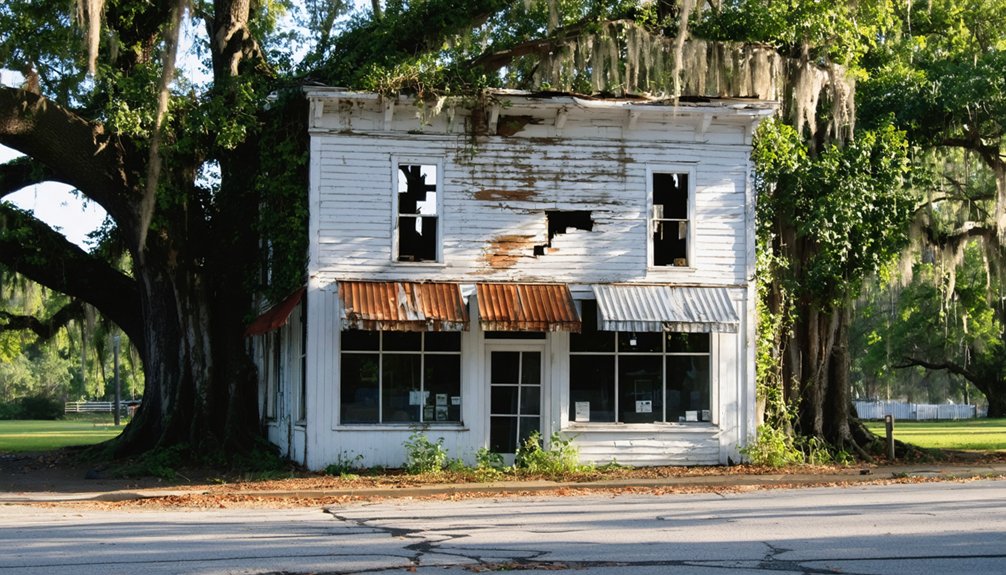
Once a vibrant 19th-century settlement, Constitution’s journey from prosperity to abandonment mirrors many small Georgia communities caught in the wake of urban expansion.
Despite its early community resilience, the town’s fate shifted dramatically after Atlanta’s 1952 annexation of the Thomasville area, which claimed half of Constitution’s remaining territory.
You’ll find that post-World War II suburbanization dealt further blows to this once-thriving town.
As railroad importance diminished and transportation routes changed, businesses relocated and populations dwindled.
Urban decay set in as buildings fell into disrepair or faced demolition.
Today, you’ll see few traces of the original town that once bustled with agricultural and commercial activity.
Constitution’s transformation from an independent community to a ghost town reflects the broader pattern of small Georgia towns overwhelmed by metropolitan growth.
Environmental Preservation and Wildlife
While Constitution’s abandoned structures slowly decay, its environmental challenges paint a stark picture of industrial impact on Georgia’s natural heritage.
You’ll find that wildlife conservation efforts here reflect broader regional struggles, particularly with the loss of longleaf pine forests and cypress swamps that once defined the landscape. The area’s transformation highlights the urgent need for habitat restoration, as industrial activities continue to threaten local ecosystems and water quality.
- Historical logging practices have dramatically altered natural habitats, affecting native species’ survival.
- Water pollution from industrial sources poses ongoing risks to aquatic wildlife.
- Local community initiatives are pushing for environmental testing and sustainable practices.
Despite these challenges, you’ll notice growing community involvement in preservation efforts, though much work remains to protect the region’s biodiversity and restore its natural balance.
Legacy in DeKalb County’s History
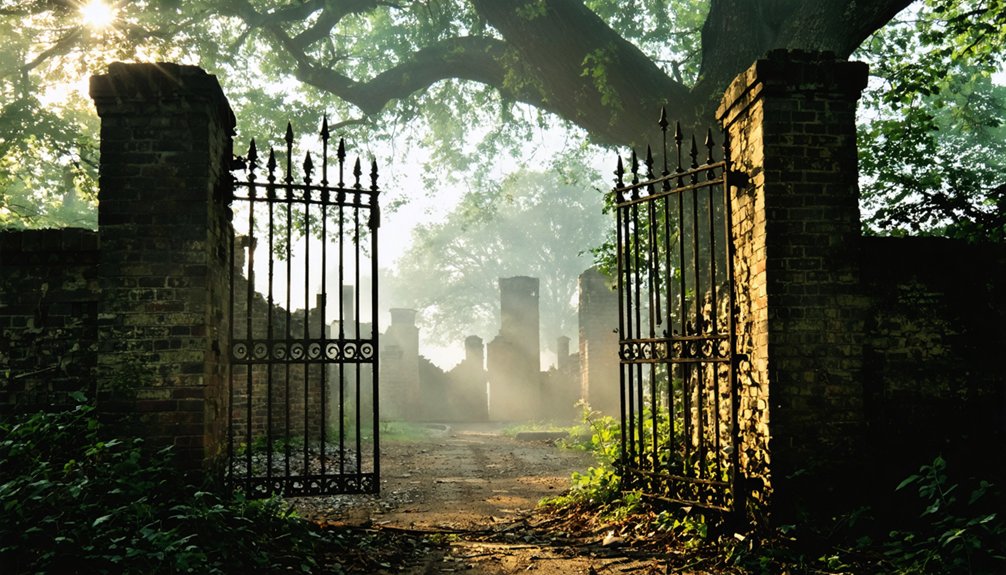
Beyond its environmental challenges, Constitution’s enduring mark on DeKalb County’s history stands as a compelling demonstration of urban evolution.
You’ll find its legacy preserved as the county’s only recognized ghost town, a symbol of the region’s dynamic transformation from pre-Civil War settlement to industrial hub.
The town’s cultural identity lives on through Constitution Lakes Park, where you can explore walking trails that tell the story of its brick-making past.
Since DeKalb County’s purchase of the land in 2003 for $1.28 million, historical preservation efforts have focused on maintaining this unique heritage.
The site’s complex narrative, from its circular city limits straddling two counties to its eventual absorption by Atlanta, reflects broader patterns of urban development that have shaped DeKalb’s landscape over generations.
Frequently Asked Questions
What Happened to Constitution’s Original Buildings and Homes?
You won’t find Constitution’s original structures today – they’ve vanished without historical preservation efforts. Despite their architectural significance, the homes and depot gave way to industrial development and Atlanta’s expansion.
Are There Any Living Descendants of Constitution’s Founding Families?
You’ll find it challenging to confirm any living descendants with certainty. While descendant stories might exist in DeKalb County’s records and family legacies could survive nearby, there’s no concrete documentation of founding families’ heirs.
When Was the Last Recorded Resident Living in Constitution?
While records show 50+ families lived there in 1940, you’ll find the last resident left Constitution around 1960, transforming it into a ghost town before Atlanta’s industrial expansion claimed the area.
Did Constitution Have Its Own School System or Churches?
You won’t find records of either schools or churches within Constitution’s boundaries. Historical records don’t show any church significance or school history – residents likely used facilities in nearby communities.
What Caused the Final Decline and Abandonment of Constitution?
You’ll find that economic factors hit Constitution hard when Atlanta’s 1952 annexation split the town, leading to population decline as businesses closed and residents sought better opportunities elsewhere.
References
- https://dekalbhistory.org/blog-posts/the-forgotten-town-of-constitution-georgia/
- https://en.wikipedia.org/wiki/List_of_ghost_towns_in_Georgia_(U.S._state)
- https://dlg.usg.edu/record/g-hi_g-hiia_collectionsofgeo04jone
- https://saportareport.com/city-kicks-off-abandoned-atlanta-constitution-building-redo/columnists/delaney-tarr/delaneytarr/
- https://commissionerlarryjohnson.com/constitution-lake-park/
- https://vanishinggeorgia.com/tag/georgia-ghost-towns/
- https://roughdraftatlanta.com/2021/05/23/travels-with-charlie-georgias-ghost-towns-slideshow/
- https://en.wikipedia.org/wiki/Constitution
- https://freepages.rootsweb.com/~gtusa/history/usa/ga.htm
- https://evhsonline.org/archives/45545
